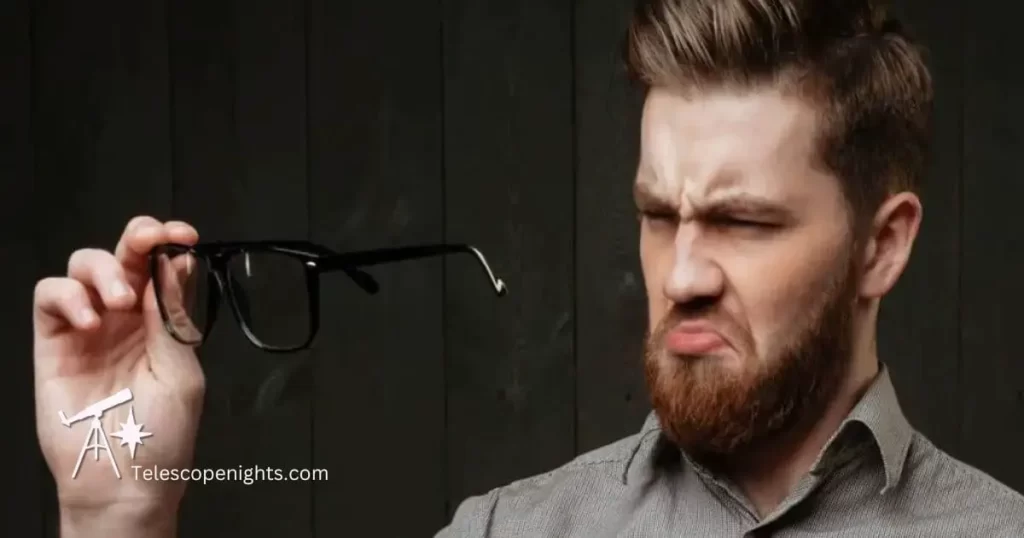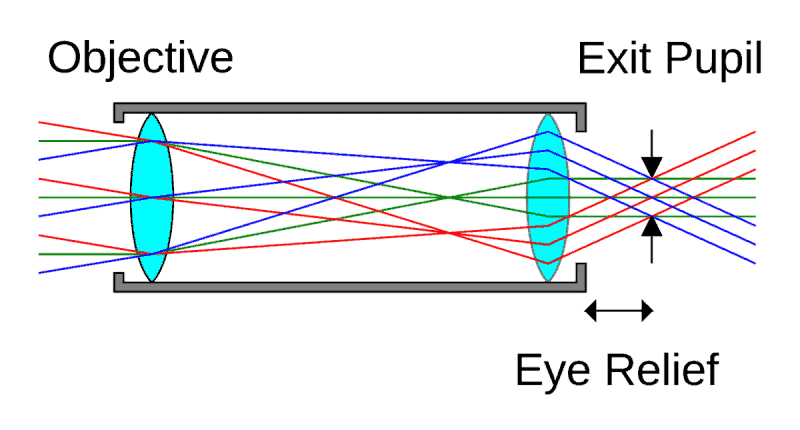Should I use my telescope with or without my glasses? It’s a dilemma most eyeglass wearers have when using a telescope. The answer depends on your need for glasses and if you have an astigmatism or not.

Just to be clear, this article relates to astigmatism in your eyes, rather than telescope astigmatism, which can affect refractor telescopes — I cover this astigmatism in telescope problem and its solutions in another article.
Can you look through a telescope with glasses?
If you are far-sighted or near-sighted, you don’t need to wear eyeglasses when using a telescope. You simply adjust the focus. However, you may need to wear them if you have astigmatism.
So if your eyewear only corrects for spherical power, i.e. nearsightedness or farsightedness, there’s no need to use a telescope with glasses because you can compensate for these by simply adjusting the focus.

If you have astigmatism, adjusting the focus won’t necessarily provide the cylindrical correction you need. It’s not as simple a solution if you have astigmatism. However, there are ways to compensate…
What is astigmatism?
Astigmatism is when your eye shape deviates from what is considered the normal spherical curvature. Rather than a round ball, it’s shaped more like a football.
With astigmatism, what you see is blurry or distorted because the deviated shape prevents light rays from meeting at a common focus. So what you see is out of focus.
There are a few types of astigmatism and it is estimated that about a third of the population has some degree of astigmatism.1
Sometimes you can get away without using eyewear because your eye muscles compensate for the distortion. I managed to do this for many years…no longer.
Using a telescope with astigmatism
If you have a fair amount of astigmatism, you will need your prescribed eyewear when using a telescope (or binoculars)…generally speaking.
There are exceptions and limits. I tend to not wear my glasses when looking through the telescope but there are times I will use them, e.g. when my eyes are feeling strained or I’m tired.
When using a telescope to view planets (like Jupiter) or objects that are distant, you mightn’t need glasses at mid to high magnifications (shorter focal lengths) –- depending on your astigmatism.
Where the exit pupil of the telescope is small and the light entering your eye tiny, you might find negligible irregularities from your astigmatism.
You might get away with no eyewear and the less-expensive shorter eye relief types for eyepieces up to a certain focal length limit.
Astigmatism and eyewear-free limit
To find your eye-wear-free limit, you can try this technique. You increase the power of your eyepieces from low to high (long to short in length) one by one using individual eyepieces or you can use a Barlow lens or a combination of these.
With your eyepiece in place, look at a bright star centered in your view, and see if there is any distortion. If there is no distortion, try the next eyepiece and repeat until you find the limit of focal length…where distortion occurs.
Alternatively, you can use the one eyepiece (with the longest FL = largest exit pupil) and mask the telescope’s aperture with a series of paper circular cut-outs to reduce the telescope’s focal ratio in increments… theoretically reducing the exit pupil in size by 1/2, 1/4, etc.
For example, if you have an f/7 telescope and the eyepiece FL is 42 mm, you have a 6 mm exit pupil (42÷7=6).
Reducing the opening to ¾ of the aperture will yield a 4.5 mm exit pupil. An opening that’s ½ of the telescope’s aperture will yield a 3 mm exit pupil, and one that’s ¼ of the aperture will yield a 1.5 mm exit pupil.
The trick is to find the largest exit pupil that offers no interference from astigmatism. The exit pupil is the round frame of light emitted from the telescope eyepiece (see image).
The exit pupil at this point indicates the upper eyepiece focal length limit you can use without glasses.
- Eyepiece focal length = Exit pupil x telescope focal ratio
For example, if a 3 mm exit pupil is the limit without distortion, and you have a telescope with an f/7, a 21 mm eyepiece is your upper focal length limit without glasses. That is, with an eyepiece longer than 21 mm you’ll need to wear eyewear for best views.
Using a telescope with Glasses or contact lenses
Rather than glasses, some folk opt to wear contact lenses that correct for astigmatism while using a telescope or binoculars.
Using contact lenses with optical instruments, such as a telescope or binoculars, will depend on your degree or type of astigmatism and how satisfied you are with wearing contacts.
Some users with enough astigmatism swear that contact lenses have dramatically improved their experience of using binoculars and a telescope.
The downside of wearing contacts is that your eyes can feel tired at the end of the day. If you intend to observe the sky at night, an option is to take the contacts out a few hours before dark and wear glasses until it’s time to view the night sky.
If you’d rather wear glasses than contact lenses or prefer to go without eyewear, read on. It’s worth noting that wearing glasses can cause extra light loss or scattering and unwanted reflections! Eyepieces with long eye relief help with this.
If you wear glasses, eyepieces with long eye relief might suit you better as they are designed to give you more comfort when using a telescope.
Having a coating on your eyeglasses to reduce reflection and flaring is also a good idea. I wrote about the different coating types that help with this.
Long eye relief eyepieces
If you prefer or need to wear glasses, eyepieces with long eye relief of at least 15 mm are meant for eyeglass wearers, to give comfort while viewing.
See my recommended long eye relief eyepiece for eyeglass wearers below.
You might find these eyepieces more expensive than the standard type. They are also larger and weightier. To save on costs, one option for eyeglass wearers is to incorporate a Barlow lens with eyepieces fitted for long eye relief and designed for low power (longer focal lengths).
An added Barlow lens to these will increase the power while retaining the comfort of long eye relief with fewer eyepieces needed.
Eye relief starts at 10 mm. For eyeglass wearers look for at least 15 mm. Though, many choose 20 mm for a comfortable fit.
About eye relief
This applies to telescopes, binoculars, and microscopes. Eye relief is the distance (mm) between your eye and the instrument’s eyepiece that gives a full field of view comfortably.

Is it your eyes or the eyepiece?
Most people know it if they have astigmatism. Without correction, astigmatism will make stars appear spiky or fuzzy around the edges. Then again, you may not know you have it, if is not major or if your eye muscles compensate for it.
If you are not sure whether the distortion you see through the eyepiece is because you have astigmatism or because your eyepiece is faulty or the instrument needs collimating, you can do the following…
To find out if the distortion is because of your eyes here is a simple test.
- View a bright night sky object with the lowest-power eyepiece in your telescope (to give you the largest exit pupil).
- Rotate your head and see if any irregularities move with your change in direction.
If this happens, you have astigmatism or another eyesight condition affecting the view rather than a faulty eyepiece or telescope.
If you do have astigmatism, you are likely to see irregularities around the perimeter of the object you are viewing. And, you’ll see this more so with the lowest power eyepieces, the largest exit pupils.
Small exit pupils won’t necessarily reveal eyesight astigmatism and this is why users sometimes think that the problem is the eyepiece without considering their eyesight.
Using telescope with glasses
Some eyepieces are better than others when it comes to using a telescope with glasses.
Recommended eyepiece for eyeglass wearers
If you are telescope viewing with glasses and want a good eyepiece, one with large eye relief, then consider the Explore Scientific 92º 17 mm (also available in 12 mm).
It has long eye relief (20 mm) and is lower in price than the top-rated, but users claim it is of good quality with excellent ergonomics. It is weightier than short eye relief eyepieces, but that is to be expected.
You can get this at Amazon.com — See details (affiliate link)
For getting the best eyepiece for your telescope kit, check out my article with recommendations from seasoned amateur astronomers.
Summary of telescope viewing with glasses
There’s no need to wear glasses if you have them for farsightedness or nearsightedness.
Options for using a telescope if you suffer astigmatism are to wear eyeglasses or toric contacts (or otherwise use TV Dioptrx correctors).
Long eye relief eyepieces are best if you need to wear glasses.
Info sources
- Jenean Carlton. 2013. Basic and Beyond: Astigmatism. Eyecare Business.
